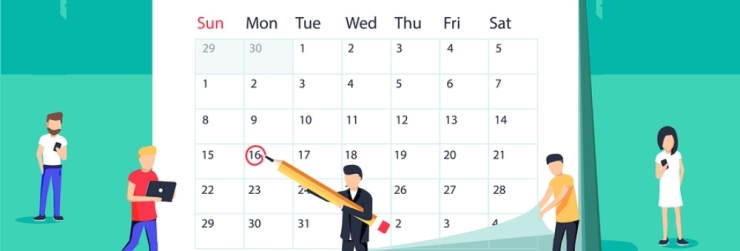Empowering Your Contact Centre During A Time of Instability
Scott Budding, Workforce & Process Optimisation Manager at Business Systems UK Ltd
Workforce Management (WFM) is a true passion of mine, I really am a true WFM enthusiast!
There’s so much to deliberate around it and the domino impact It can have on an organisation if done correctly (as well as incorrectly) is truly fascinating.
So, to all the resource planners, analysts, workforce managers out there – I truly salute you, especially at a time like this where COVID has thrown many unpredictable scenarios into the mix and you’re keeping it going.
This is an unpredictable time, and we’re guiding our customers through it. So, when I was asked to host a joint partner webinar with Calabrio involving Dave Hoekstra, another WFM enthusiast, I jumped at the opportunity.
So many great takeaways came out of it. Here are my top 4:
Real-Time Adherence for Visibility
We need visibility of our agents now more than ever, particularly with remote working. And not just in a ‘big brother’ type of way, but in a supportive way. This is where Real-Time Adherence (RTA) within WFM comes in.
Real-Time Adherence allows you to compare agent schedules with those of the current ACD state. It can flag lack of schedule adherence with alarms (can be customised based on different thresholds) and provides real-time adherence visibility to ensure staff are available for the next customer demand/interaction.
One of the benefits of RTA is that it helps you understand where your agents might need extra support. Why are alarms being triggered – what is the trend and how can you help? It may be that some agents are struggling with homeworking (for example). If they are then is this down to technology or something related to their mental health / wellbeing? Either way, by being alerted to it we can the address / support accordingly.
Alarms can be set for all scenarios – think about which alarms you can set that will help support your agents. For example, alarms which are triggered when an agent is on a call for more than 10 minutes, alerting you to message them and ask them if everything is okay.
The technology can also be customised so that activity alert reminders pop up on your agent’s desktop, reminding them when it’s time to take a break or to go for lunch. Particularly important for agents who are working from home.
A recent Business Systems webinar poll provided us with insight that a third of organisations are currently working without real time visibility. The technology is out there to make your lives easier, so investigate your options!
If there’s one sentence that will sum up RTA, it’s that it will bring you quick and easy productivity gains by being able to measure your agents in real time.
Agent Morale
Agent morale has and will always be an important topic within the contact centre industry. Creating a culture which boosts employee engagement is vital in the customer service led world we now live in. Here are different ways you can boost agent morale:
– Involve your agents in the contact centre process – empower them to have a say in schedules, identify coaching needs and include them in decision making.
– Incorporate Gamification
– Offer self-service options so that agents can move breaks, lunches, request overtime and swap shifts on their own accord (based on pre-set parameters)
*This can even be done through a mobile app – popular with all staff, especially the millennials and Gen Z’s!
Setting Expectations – Customer & Stakeholders
One of the polls we ran during the webinar showed us that nearly 50% of our audiences CSAT scores had been affected by COVID-19.
If you’ve had a drop in your CSAT scores, then take a step back and consider the reasons as to why. Is it because of your depleted resource? Or has the level of demand that is now coming in increased? Do you need to push your customers to a different channel during this time to deliver a good service?
A top tip I have is when looking at cutting down your volume and workload, consider how you can cut down your average handle time, for example do you really need to ask all of your security questions you are asking today to remain compliant? Review your existing processes such as scripts or statements. Can you save time during the call as well as improving customer satisfaction by cutting these processes down?
At a time like this, you will also be managing stakeholder expectations within the contact centre. In terms of your operating model, take a step back and review it.
There is no rulebook for this, and you do not have to have the same target service level you had a few weeks ago. That would be unrealistic.
Be realistic with your goals and explain why they may have changed and use data as much as you can to back your points up. For example, you may have found that since the pandemic started your workload has doubled. It would be unrealistic to assume you would have the same speed of answer as you did pre COVID (assuming operating with same resource levels, or fewer) and nobody wants to see a daily report full or “red” for the next X number of weeks / months.
Review these targets weekly. It’s a constantly evolving situation and so your targets/goals will not be able to stay the same. But we hope as you review and tweak, they head in the direction of the “norm”.
Forecasting & Scheduling
It’s difficult at the moment to set expectations in terms of forecasts, so this is a great opportunity to make use of ‘what-if scenarios’ within your WFM system. ‘What-if scenarios’ can help you understand the impact of events on the future and recognise what actions need to be taken. They can be used to create prediction bands (upper – baseline – lower).
It’s a truly powerful tool when you can map out different scenarios with a snapshot into what the business will look like in different situations such as if a second wave hits or if 40% of your workforce is off sick at a period in time, or if you have a need to schedule a 50/50 split of homeworkers and office based workers to ensure social distancing continues in the near future.
When mapping your forecasting scenarios, don’t forget to layer in intelligence from different areas of the business such as Marketing, Sales or Finance.
When it comes to scheduling right now, have you invested time to speak to your agents and understand how things might have changed from an availability point of view? For example, you may have agents who now they are working from home and their children are not at school, would prefer having the mornings off and working the later shifts. Or perhaps it suits them to work micro-shifts or split shifts to top and tail homeschooling. We’re good at telling our employees when they should work, but not so good at asking them. You might find that different preferences are exactly what your schedule needs right now. Factoring in your staff flexibility and preferences is now more important than ever.

For additional information on Business Systems visit their Website or view their Company Profile






